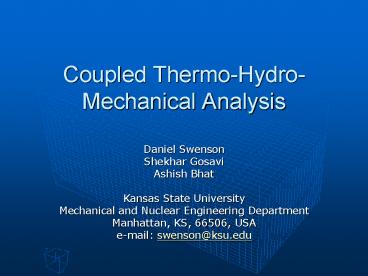Coupled Thermo-Hydro-Mechanical Analysis - PowerPoint PPT Presentation
1 / 33
Title:
Coupled Thermo-Hydro-Mechanical Analysis
Description:
Objective Approach Couple deformation/stress analysis with TOUGH2 Couple ... Equations Darcy s law ... flow in porous and fractured media. – PowerPoint PPT presentation
Number of Views:136
Avg rating:3.0/5.0
Title: Coupled Thermo-Hydro-Mechanical Analysis
1
Coupled Thermo-Hydro-Mechanical Analysis
- Daniel Swenson
- Shekhar Gosavi
- Ashish Bhat
- Kansas State University
- Mechanical and Nuclear Engineering Department
- Manhattan, KS, 66506, USA
- e-mail swenson_at_ksu.edu
2
Objective
To provide coupled thermal-hydraulic-mechanical
analysis tools that enable quantitative
understanding and prediction of thermal effects
on flow in the reservoir.
3
Approach
- Couple deformation/stress analysis with TOUGH2
- Couple wellbore model with TOUGH2
- Apply these tools to the analysis of Coso
injection
4
Status
- Implemented one way (forward) coupling
- Implemented back coupling effect on hydraulic
properties (porosity and permeability) without
full Jacobian terms. - Now implementing full Jacobian solution
- Expect to have working version first quarter of
2005
5
System Equations for Stress Coupling
- Conservation Equations
- Mass
- Energy
- Momentum
- Constitutive Equations
- Darcys law (Advective Flux)
- Ficks law (Diffusive Flux)
- Fourier law (Thermal)
- Terzaghis Principle (Effective Stress)
6
Fluid Mass Balance
7
Change in Hydraulic Properties
- Porosity
- Permeability
- Capillary Pressure
8
Discretization
- Fluid Flow IFDM
- TOUGH2 Mesh
9
Discretization (Contd.)
- Momentum FEM
- Cartesian Dual
10
Dual Mesh
- TOUGH2 Mesh
- Cartesian Dual
TOUGH2 Cell Center
FEM Node
11
Solution Technique
- Newton-Raphson (TOUGH2)
- Jacobian Representation
12
Jacobian Modifications (Contd.)
- Solid-Fluid Coupling
- Volumetric Strain (IFDM)
n
m
13
Motivation for Coupling of Wellbore Model
- Settings at Coso (EGS) site
- Low permeability
- Significant drawdown
- Presence of two-phase flow and multiple feedzones
- Our goal is to provide enhanced capability in
TOUGH2 to- - Better model flow in geothermal systems
containing inclined wells with multiple feedzones - account for varying flowing bottomhole pressure
14
HOLA wellbore Simulator
- Multi-feedzone wellbore simulator for pure water
- GWELL and GWNACL-extensions of HOLA
- Can handle steady state, one-dimensional flow
(single and two-phase) in the well with varying
well-radius - 2 approaches
- Option 1 (Wellhead-to-Bottomhole)
- Option 2 (Bottomhole-to-Wellhead)
- Simulates both production and injection
15
Background
- Murray and Gunn (1993) coupling between TETRAD
and WELLSIM - Hadgu et al., (1995) TOUGH2 and WFSA
- Coupled wellbore flow option in TOUGH2
- tables are generated for each well that are used
for interpolation. - limited to single feedzone
16
Coupling of HOLA with TOUGH2
- Some features of the coupled code are,
- No change in TOUGH2 input file
- H---- type of record in GENER block indicates
coupled simulation - Input file format for the well is in similar
spirit of HOLA - Wellhead pressure as a time-dependent tabular
data - Shut-in/Flowing option
17
Coupling of HOLA with TOUGH2 (Contd.)
- PROCEDURE
- Read input file
- Obtain required reservoir parameters
- Call HOLA at the start of each new time-step
- A positive(/negative) flowrate at a feedzone in
HOLA is supplied as production(/injection) rate
in the corresponding source/sink element in
TOUGH2 - Enthalpy of a producing element is calculated in
TOUGH2, while for injection it comes from HOLA - Repeat steps (ii) to (v) for the next time-step
with updated values of reservoir parameters.
18
Coupling of HOLA with TOUGH2 (Contd.)
- Minimal changes made to TOUGH2
- Issues in HOLA
- Averaging of parameters in routine VINNA2
- Relative permeability calculations
- Instances of un-initialized variables being used
- Division by zero
- Inclined wells
- Hard-coded simulation parameters
19
Sample Problem
- Sample problem 5 from TOUGH2 users guide
- Well with inside diameter 0.2 m
- 500 m thick, two-phase reservoir
- Water at P 60 bars, TTsat(P) 275.5 C, Sg
0.1 - Wellhead pressure 7 bars
- feedzone depth 1000 m
- 1-D radial mesh, extends 10,000 m
- Well Productivity Index 4.64e-11
- Simulation starts with a time-step of 1.e5 sec
and ends at time, 1.e9 sec (approx. 31.7 years)
20
Sample Problem (contd.)
- Results obtained from the two runs plotted
- These trends match with those obtained in TOUGH2
guide
21
Current/Future Work
- Revisit the convergence methodology implemented
in HOLA - Extension to GWELL and GWNACL
- Use the coupled code to better model the wells at
Coso (EGS) site - Finished first half of 2005
22
Acknowledgements
- Karsten Pruess and Jonny Rutqvist, LBNL.
- Teklu Hadgu, Sandia National Laboratories.
- This work is supported by the U.S. Department of
Energy, under DOE Financial Assistance Award
DE-FC07-01ID14186.
THANK YOU
23
Mass Balance (Contd.)
- Solid
- Solid Density
where
24
Mass Balance (Contd.)
- Fluid
TOUGH2
Skeleton
Solid Grains
25
Energy Balance
- General
- Using Internal Energy
- Neglecting conversion of KE to IE
26
Momentum Conservation
- General
- Static Equilibrium Equation
- Neglecting inertial terms
27
Jacobian Modifications
- Individual Term
- Fluid Flow
28
Jacobian Modifications (Contd.)
- Stress Equilibrium
29
Constitutive Laws
- Darcys Law (Advection)
- Ficks Law (Diffusion)
- Fouriers Law (Heat Conduction)
30
Jacobian Modifications (Contd.)
- Fluid-Solid Coupling
- Internal Forces Dual Mesh
31
Effective Stress Law
- Effective Stress
- Stress-Strain
32
TOUGH2 simulator
- Numerical simulator for multi-phase fluid and
heat flow in porous and fractured media. - A well is represented in a simplified manner
- Well on deliverability model
- fixed bottomhole pressure
- production rate is calculated as,
- Coupled wellbore option
33
Sample Problem (contd.)































